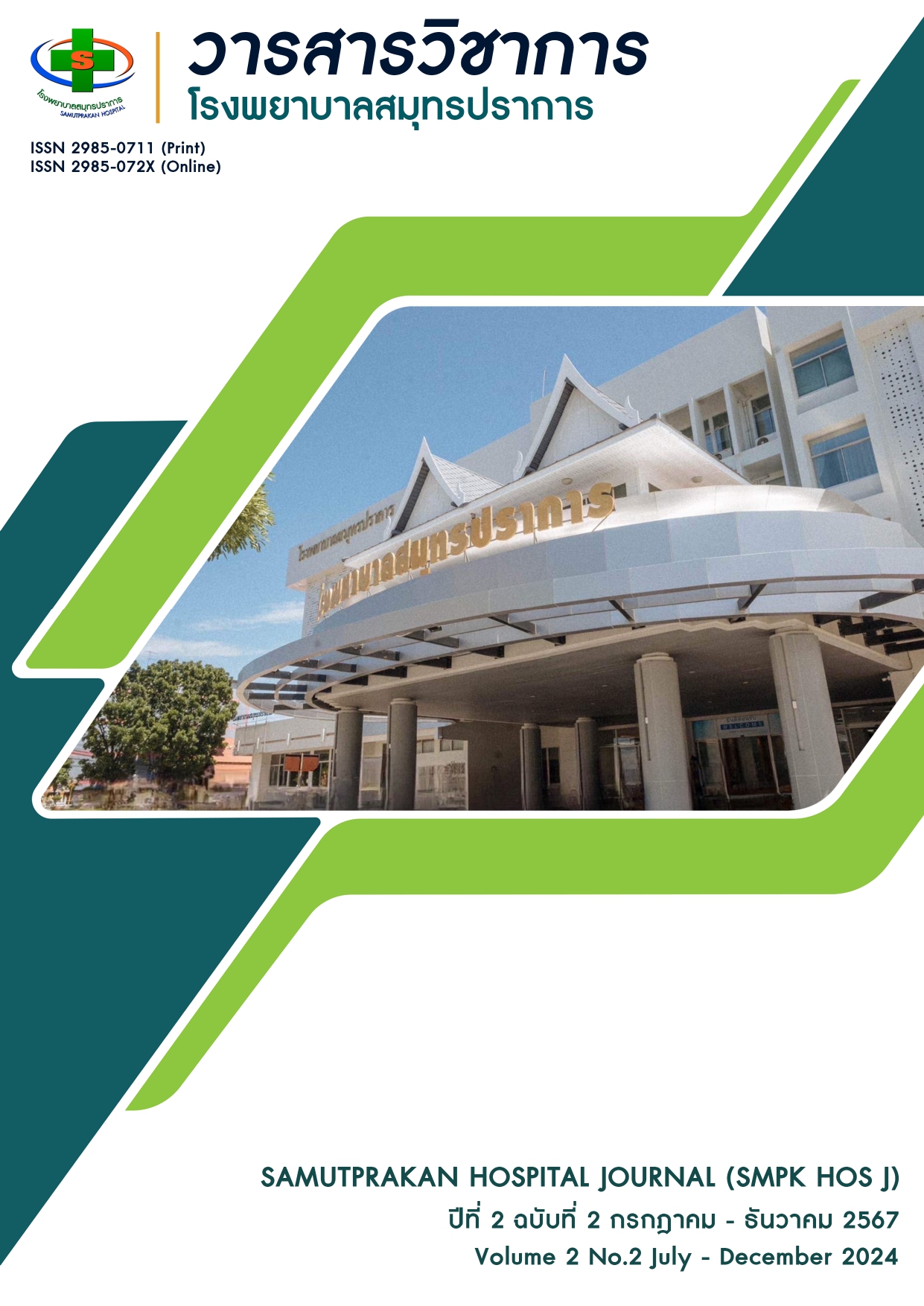Distribution of Vancomycin Resistance Genes in Enterococci Isolated from Patient Specimens at Samutprakan Hospital
Keywords:
VRE, Enterococci, Vancomycin ResistanceAbstract
Antimicrobial resistance poses a global crisis, affecting humans, animals, food, and the environment. In Thailand, Enterococci are recognized as important pathogens in nosocomial infections. Vancomycin-resistant Enterococci (VRE) are classified as high-priority drug-resistant bacteria due to their significant impact on human health, animals, food, and the environment. Therefore, monitoring drug resistance trends is crucial for effective treatment, prevention, and developing guidelines for infection control in hospitals.
This study surveyed the distribution of vancomycin-resistant genes in Enterococci isolated from patient specimens at Samutprakan Hospital. The highest proportion of isolates was identified as Enterococcus faecalis (61.5%), followed by Enterococcus faecium (33.9%) and other Enterococci (4.6%). However, the highest rates of VRE were found in Enterococcus faecium (5.3%), followed by Enterococcus faecalis (0.1%). Of the 48 VRE strains collected between January 2022 and June 2023, all (100%) were identified as Enterococcus faecium. Moreover, all strains harbored the vanA gene, with a vancomycin Minimal Inhibitory Concentration (MIC) value of > 256 µg/ml.
Interestingly, 62% of the strains were sensitive to Teicoplanin. Additionally, VRE strains exhibited sensitivity to Linezolid (100%), Daptomycin (94%), and Tetracycline (82%).
References
คณะกรรมการนโยบายการดื้อยาต้านจุลชีพแห่งชาติ. แผนปฏิบัติการด้านการดื้อยาต้านจุลชีพแห่งชาติ ฉบับที่ 2 พ.ศ. 2566-2570
วิษณุ ธรรมลิขิตกุล. คู่มือการควบคุมและป้องกันแบคทีเรียดื้อยาต้านจุลชีพในโรงพยาบาล.โครงการควบคุมและป้องกันการดื้อยาต้านจุลชีพในประเทศไทย. 2558
National Antimicrobial Resistance Surveillance center, Thailand. แนวทางการเฝ้าระวังการดื้อยาต้านจุลชีพภายใต้แนวคิดสุขภาพหนึ่งเดียวประเทศไทย. 2566
Said MS, Tirthani E, Lesho E. Enterococcus Infections [Internet]. 2023. [cited 2023 Apr 10]. Available from: https://www.ncbi.nlm.nih.gov/books/NBK567759
สมศักดิ์ ราหุล, อนุศักดิ์ เกิดสิน. การวินิจฉัยแบคทีเรียก่อโรคกลุ่มต่างๆและเชื้อราที่พบบ่อย. ใน: มาลัย วรจิตร, วันทนา ปวีณกิตติพร, สุวรรณา ตระกูลสมบูรณ์, สุรางค์ เดชศิริเลิศ, บรรณาธิการ. คู่มือปฏิบัติงานแบคทีเรียและรา สำหรับโรงพยาบาลศูนย์และโรงพยาบาลทั่วไป. พิมพ์ครั้งที่ 3. กรุงเทพมหานคร:บริษัท พรีเมียร์ มาร์เก็ตติ้ง โซลูชั่น จำกัด; 2561.น. 101-12.
Parlak H, Tan H. Pancytopenia due to linezolid treatment. Turk Pediatri Ars 2015; 50:185-8.
McConnella A, Baerg K. Peripheral neuropathy from use of linezolid and metronidazole in a pediatric patient. IDCases 2021; 25: e01210.
Mao Y, Dai D, Jin H, Wang Y. The risk factors of linezolid-induced lactic acidosis. Medicine 2018;97:36 (e12114).
Molton JS, Tambyah PA, Ang BS, Ling ML, Fisher DA. The global spread of health care associated multidrug-resistant bacteria: a perspective from Asia. Clin Infect Dis 2013 May;56(9):1310-8.
ศูนย์ระวังเชื้อดื้อยาต้านจุลชีพแห่งชาติ (NARST) สถาบันวิจัยวิทยาศาสตร์สาธารณสุข กรมวิทยาศาสตร์การแพทย์. สถานการณเชื้อดื้อยาต้านจุลชีพ ปี 2000-2022 (12M) [Internet].2023 [cited 2023 Apr 10]. Available from: http://narst.dmsc.moph.go.th/data/AMR%202000-2022-12M.pdf
Centers for Disease Control and Prevention. Vancomycin-resistant Enterococci (VRE) Basics [Internet]. Jan 22, 2024 [cited 2024 Apr 12]. Available from: https://www.cdc.gov/vre/about/CDC_AAref_Val=https://www.cdc.gov/hai/organisms/vre/vre.html
Kampmeier S, Tönnies H, Correa-Martinez CL, Mellmann A, Schwierzeck V. A nosocomial cluster of vancomycin resistant enterococci among COVID-19 patients in an intensive care unit. Antimicrob Resist Infect Control 2020;9:154.
Asgin N, Otlu B. Antibiotic Resistance and Molecular Epidemiology of Vancomycin-Resistant Enterococci in a Tertiary Care Hospital in Turkey. Infect Drug Resist 2021; 191-198, DOI: 10.2147/IDR.S191881.
หัสญา ตันติพงศ์. ปัจจัยที่มีความสัมพันธ์กับการติดเชื้อหรือตรวจพบเชื้อเอนเทอโรคอคซัยที่ดื้อต่อยาแวนโคมัยซินในผู้ป่วยที่รับการรักษาในโรงพยาบาลชลบุรี.วารสารโรงพยาบาลชลบุรี 2563; 45(2):95-106
Zhou W, Zhou H, Sun Y, Gao S, Zhang Y, Cao X, et al. Characterization of clinical enterococci isolates, focusing on the vancomycin-resistant enterococci in a tertiary hospital in China: based on the data from 2013 to 2018. BMC Infect Dis 2020;20:356
Bocanegra-Ibarias P, Flores-Trevino S, Camacho-Ortiz A, Morfin-Otero R, Villarreal-Trevino L, Llaca-Díaz J, et al. Phenotypic and genotypic characterization of vancomycin-resistant Enterococcus faecium clinical isolates from two hospitals in Mexico: First detection of vanB phenotype-vanA genotype. Enferm Infecc Microbiol Clin 2016;34(7):415–21.
Khairy RM, Mahmoud MS, Esmail MAM, Gamil AN. First detection of vanB phenotype-vanA genotype vancomycin-resistant enterococci in Egypt. J Infect Dev Ctries 2019;13(9):837-842. doi:10.3855/jidc.10472
Yan MY, He YH, Ruan GJ, Xue F, Zheng B, Lv Y. The prevalence and molecular epidemiology of vancomycin-resistant Enterococcus (VRE) carriage in patients admitted to intensive care units in Beijing, China. J Microbiol Immunol Infect 2023; 56:351-7.
National Drug Information. บัญชียาหลัก และหลักฐานเชิงประจักษ์ [Internet]. 2019 [cited 2024 Sep 4]. Available from: https://ndi.fda.moph.go.th/drug_national
ทองพูล มหาพรม, อรพรรณ สุภายอง, ดุจฤดี ชินวงศ์, สุระรอง ชินวงศ์. สถานการณ์การโฆษณายาทางสื่อวิทยุในอำเภอชนบทของจังหวัดหนึ่งทางภาคเหนือของประเทศไทย. วารสารเภสัชกรรมไทย 2562;11(4):840-9
Downloads
Published
How to Cite
Issue
Section
License
Copyright (c) 2024 Samutprakan Hospital Journal (SMPK HOS J)

This work is licensed under a Creative Commons Attribution-NonCommercial-NoDerivatives 4.0 International License.







